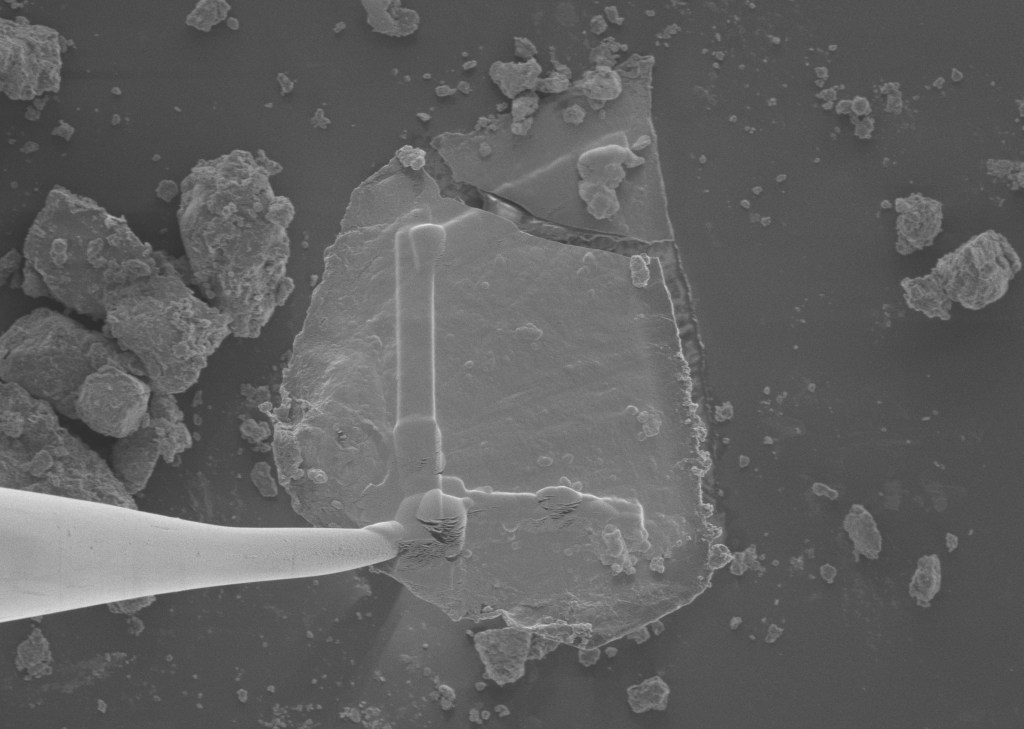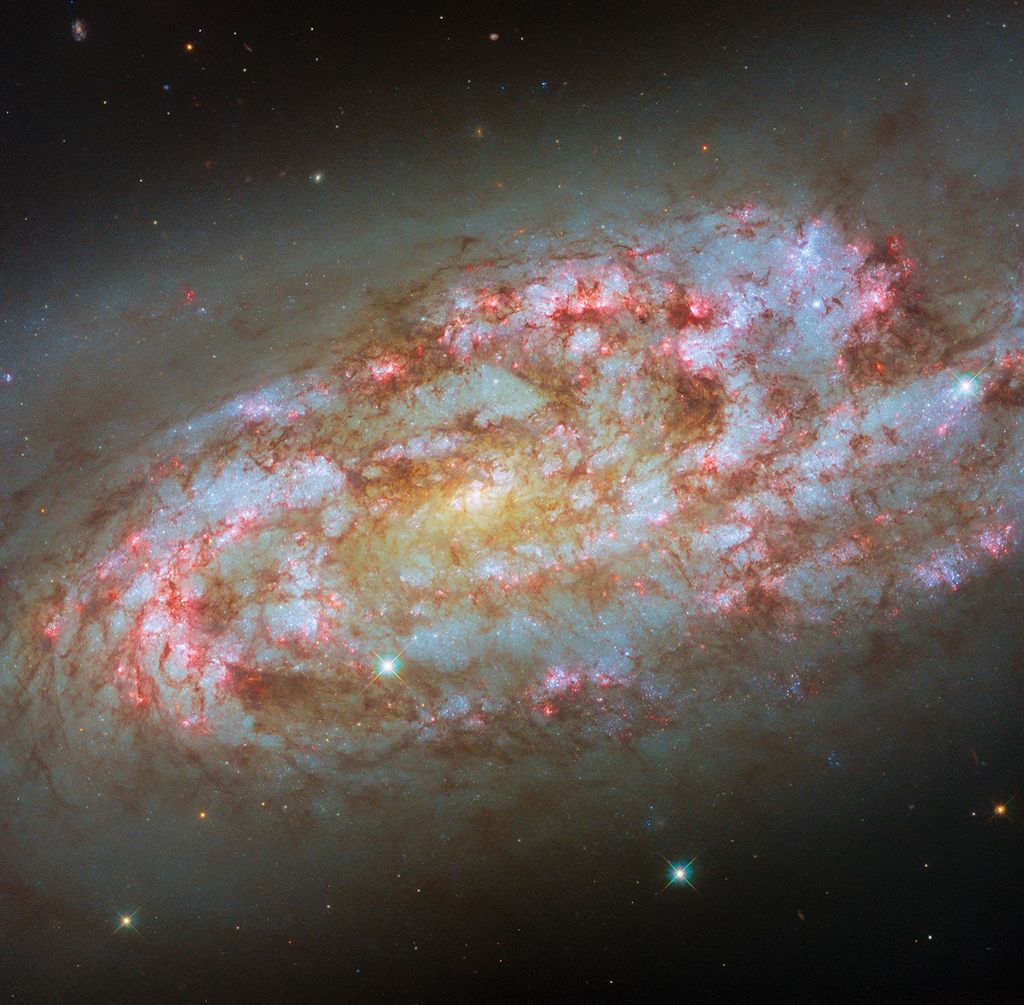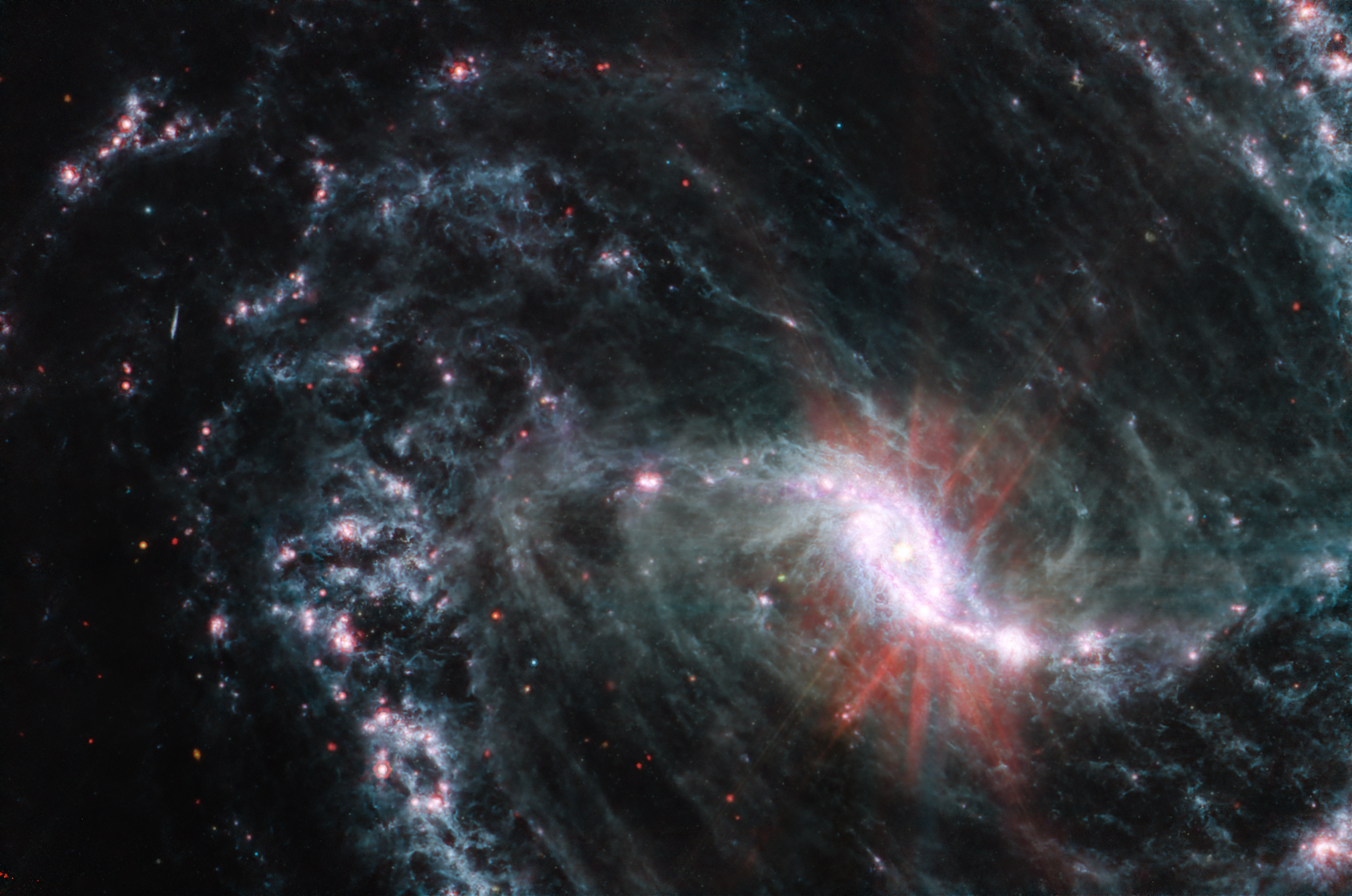1 min read
NGC 1433 (MIRI Image)
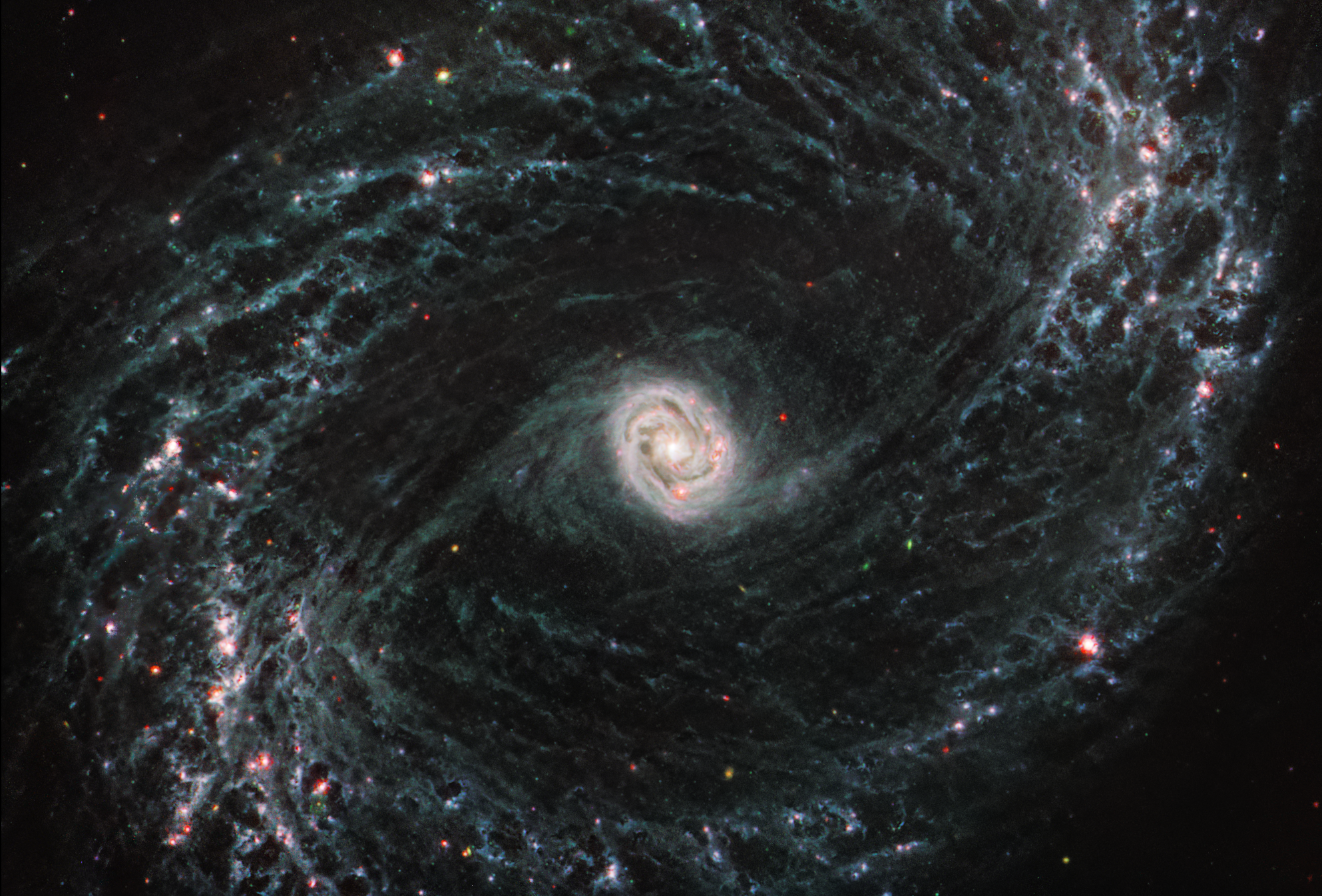
This image taken by NASA’s James Webb Space Telescope shows one of a total of 19 galaxies targeted for study by the Physics at High Angular resolution in Nearby Galaxies (PHANGS) collaboration. Nearby barred spiral galaxy NGC 1433 takes on a completely new look when observed by Webb’s Mid-Infrared Instrument (MIRI).
NGC 1433’s spiral arms are littered with evidence of extremely young stars releasing energy and, in some cases, blowing out the gas and dust of the interstellar medium. Areas that appear dark and dim in optical imaging light up under Webb’s infrared eye. This is due to clumps of dust and gas in the interstellar medium absorbing the light from forming stars and emitting it back out in the infrared.
Webb’s image of NGC 1433 is a strong display of how dynamic processes associated with forming stars influence the larger structure of an entire galaxy.
At the center of the galaxy, a tight, bright core featuring a unique double ring structure shines in exquisite detail with Webb’s extreme resolution. In this case, that ‘double ring’ is actually tightly wrapped spiral arms that wind into an oval shape along the galaxy’s bar.
NGC 1433 is a Seyfert galaxy, which are typically relatively close to Earth and has a supermassive black hole at the center eating material at a high rate. The brightness and lack of dust in the MIRI image of NGC 1433 could hint at a recent collision with another galaxy.
NGC 1433 lies over 46 million light-years away from Earth in the constellation Horologium.
MIRI was contributed by ESA and NASA, with the instrument designed and built by a consortium of nationally funded European Institutes (The MIRI European Consortium) and NASA’s Jet Propulsion Laboratory, in partnership with the University of Arizona.
About the Object
- R.A. PositionR.A. PositionRight ascension – analogous to longitude – is one component of an object's position.03:42:00.82
- Dec. PositionDec. PositionDeclination – analogous to latitude – is one component of an object's position.-47:13:28.56
- ConstellationConstellationOne of 88 recognized regions of the celestial sphere in which the object appears.Horologium
- DistanceDistanceThe physical distance from Earth to the astronomical object. Distances within our solar system are usually measured in Astronomical Units (AU). Distances between stars are usually measured in light-years. Interstellar distances can also be measured in parsecs.46 million light-years
About the Data
- Data DescriptionData DescriptionProposal: A description of the observations, their scientific justification, and the links to the data available in the science archive.
Science Team: The astronomers who planned the observations and analyzed the data. "PI" refers to the Principal Investigator.This image was created with Webb data from proposal: 2107 (J. Lee).
- InstrumentInstrumentThe science instrument used to produce the data.MIRI
- Exposure DatesExposure DatesThe date(s) that the telescope made its observations and the total exposure time.19 Jan 2023
- FiltersFiltersThe camera filters that were used in the science observations.F770W, F1000W, F1130, F2100W
- Object NameObject NameA name or catalog number that astronomers use to identify an astronomical object.NGC 1433, PGC 13586
- Object DescriptionObject DescriptionThe type of astronomical object.Barred spiral galaxy with a double ring structure
- Release DateFebruary 16, 2023
- Science ReleaseNASA’s Webb Reveals Intricate Networks of Gas and Dust in Nearby Galaxies
- CreditNASA, ESA, CSA, Janice Lee (NSF's NOIRLab); Image Processing: Alyssa Pagan (STScI)

These images are a composite of separate exposures acquired by the James Webb Space Telescope using the MIRI instrument. Several filters were used to sample wide wavelength ranges. The color results from assigning different hues (colors) to each monochromatic (grayscale) image associated with an individual filter. In this case, the assigned colors are: Blue: F770W, Green: F1000W+F1130W, Red: F2100W

Related Images & Videos

NGC 7496 (MIRI Image)
Scientists are getting their first look with NASA’s James Webb Space Telescope’s powerful resolution at how the formation of young stars influences the evolution of nearby galaxies. The spiral arms of NGC 7496, one of a total of 19 galaxies targeted for study by the Physics at...
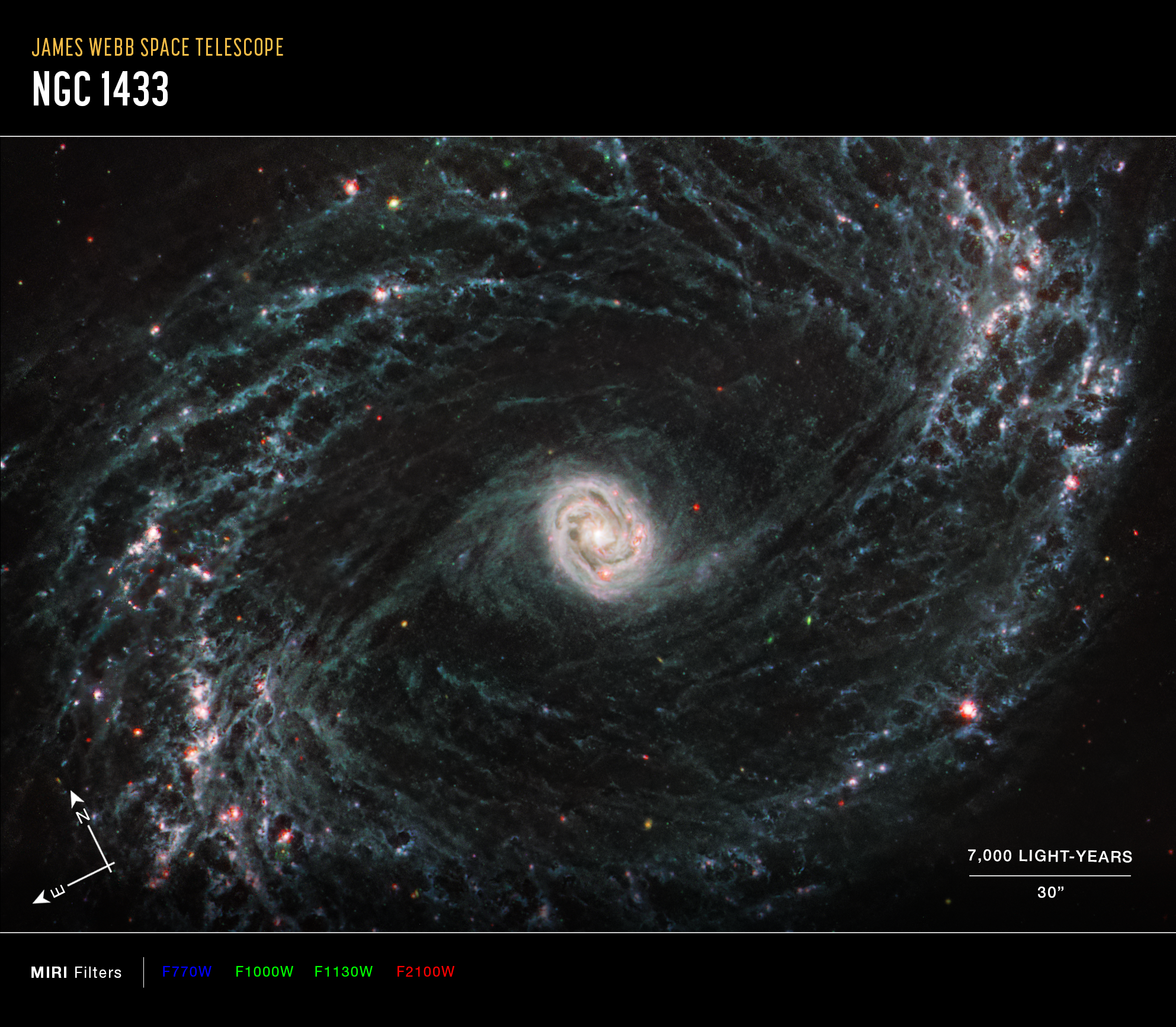
NGC 1433 (MIRI Compass Image)
This image of the nearby galaxy NGC 1433, captured by Webb’s Mid-Infrared Instrument (MIRI) shows compass arrows, scale bar, and color key for reference. The north and east compass arrows show the orientation of the image on the sky. Note that the relationship between north and...

NGC 7496 (MIRI Compass Image)
This image of the nearby galaxy NGC 7496, captured by Webb’s Mid-Infrared Instrument (MIRI) shows compass arrows, scale bar, and color key for reference. The north and east compass arrows show the orientation of the image on the sky. Note that the relationship between north and...

NGC 1365 (MIRI Compass Image)
This image of the nearby galaxy NGC 1365, captured by Webb’s Mid-Infrared Instrument (MIRI) shows compass arrows, scale bar, and color key for reference. The north and east compass arrows show the orientation of the image on the sky. Note that the relationship between north and...
Share
Details
Laura Betz
NASA’s Goddard Space Flight Center
Greenbelt, Maryland
laura.e.betz@nasa.gov
NASA, ESA, CSA, Janice Lee (NSF’s NOIRLab)
Alyssa Pagan (STScI)


